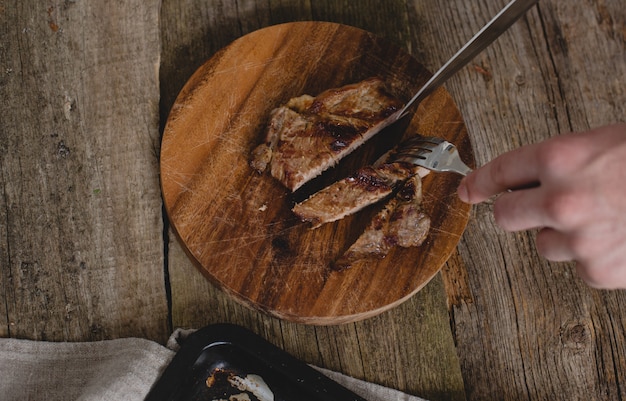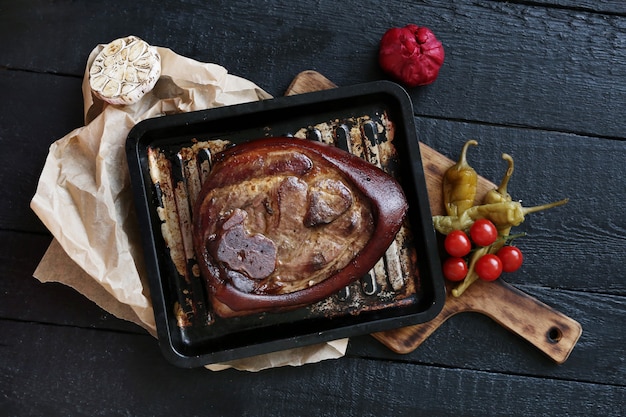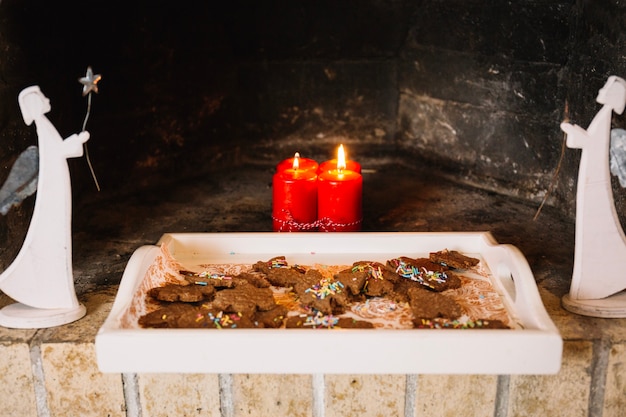You've got your eyes set on a rack of lamb, and I can't blame you! It's a beautiful cut of meat that screams "special occasion" just by its presence. But before you dive headfirst into the world of lamb roasting, let's take a step back and make sure you have all the tools, knowledge, and confidence to create a truly delicious and impressive dish.
This guide is more than just a recipe; it's your personal roadmap to mastering oven-roasted lamb. From picking the perfect rack to mastering the art of carving and serving, I'll be your guide, sharing my tried-and-true techniques and personal experiences along the way. So grab a cup of tea, get comfortable, and let's embark on this culinary adventure together!
(Part 1) Choosing the perfect rack of lamb: The Foundation of Flavor

The first step, and arguably the most important, is choosing the right rack of lamb. It’s the foundation on which your entire dish will be built. Think of it like selecting the finest ingredients for a gourmet meal - it sets the stage for a truly delicious experience.
The Cut: Unveiling the French Trim
When it comes to lamb cuts, the French trimmed rack is a personal favourite. It’s like the celebrity of the lamb world, with the bones exposed, making for a stunning presentation and providing more surface area for beautiful browning. The exposed bones also allow the heat to penetrate deeper into the meat, creating a more evenly cooked and flavorful result.
If you're after a less fancy option, a regular rack with the fat intact is a perfectly fine choice. Just remember to score the fat to create that crispy, flavorful crust.
The Fat: A Secret Weapon for Juiciness
Now, let's talk about fat, which is the secret to a juicy, tender, and flavorful roast. Look for a rack with good marbling – those beautiful streaks of fat throughout the meat. Fat is flavour, and it's essential for keeping the lamb moist during the cooking process.
The Weight: Sizing It Up for Your Crowd
Consider the weight of the rack based on how many people you're feeding. For a romantic dinner for two, a 1.5 to 2-pound rack is ideal. If you're hosting a larger gathering, aim for a 3-pound rack or even bigger.
My Advice: Seeking Expertise from the Butcher
The best way to ensure a quality rack of lamb is to visit a butcher. They're the experts, and they'll be able to guide you to the perfect cut. They can even trim the rack for you, saving you the hassle and ensuring a beautiful presentation. Don't be afraid to ask questions; they're happy to share their knowledge and help you find the perfect lamb for your occasion.
(Part 2) Preparing the Lamb: A Symphony of Flavors

With your beautiful rack of lamb in hand, it's time to prep it for the oven. This step is all about setting the stage for a symphony of flavors that will tantalize your taste buds.
Pat It Dry: The Key to a Crispy Crust
The first step is to pat the lamb dry with paper towels. This might seem like a small detail, but it's crucial for achieving that beautiful, crispy, golden-brown crust we all crave. Moisture prevents browning, so make sure the lamb is thoroughly dry before seasoning.
Seasoning Secrets: Building a Flavor Profile
Now comes the fun part - seasoning! This is where you can really make the lamb your own. A simple blend of salt, pepper, and garlic powder is a classic and always delicious. But don't be afraid to experiment with other herbs and spices. Think rosemary, thyme, oregano, paprika, or even a touch of chili flakes for a bit of heat.
Here's a little secret my mum taught me: sprinkle a pinch of sugar on top before roasting. It helps caramelize the fat and adds a touch of sweetness, creating a truly irresistible flavor profile.
Score the Fat (Optional): Unlocking Flavor and Creating a Crispy Exterior
Now for a little pro tip that makes a big difference: scoring the fat layer. This creates a crispy outer layer and allows the seasoning to penetrate deeper into the meat, unlocking even more flavor. Use a sharp knife to make shallow cuts about a half-inch apart across the fat. Don't cut too deep, as you don't want to cut into the meat itself.
Rest it Up: Letting the Lamb Relax
Finally, let the lamb rest at room temperature for about 30 minutes. This might sound like a simple step, but it's crucial for allowing the lamb to cook evenly and reach a uniform temperature throughout. It also helps to prevent the lamb from becoming too cold in the oven, which can result in uneven cooking.
(Part 3) Roasting the Lamb: A Journey to Perfection

Now we're ready to take center stage and roast that beautiful rack of lamb! This is where your culinary skills truly shine.
Preheating the Oven: The Crucial First Step
Preheat your oven to 425°F (220°C). This high temperature is essential for achieving that golden-brown crust we're aiming for. It gives the lamb a quick sear, locking in the juices and creating a beautiful presentation.
The Roasting Dish: Finding the Right Vessel
Choose a roasting pan that's large enough to accommodate your rack of lamb with a little space around it. This allows for even cooking and prevents the lamb from overcrowding, which can lead to uneven browning and steaming instead of roasting. I like to line mine with foil to make clean-up a breeze.
The Roast: Mastering the Timing
Place the lamb in the roasting pan, fat side up. This allows the fat to render and baste the meat, creating a juicy and flavorful roast. Roast for 15 minutes at the high temperature, then reduce the oven temperature to 350°F (175°C). Continue roasting until the internal temperature reaches 145°F (63°C) for medium-rare, which will take about 15-20 minutes more.
The Basting: Adding Moisture and Flavor
Now for a little secret my grandpa taught me: basting is key! Every 15 minutes or so, spoon the drippings from the bottom of the pan over the lamb. This helps keep the meat moist and adds an extra layer of deliciousness. The drippings are full of flavor, and basting ensures that the lamb is evenly cooked and succulent.
The Rest: Giving the Lamb a Moment to Breathe
Once the lamb reaches the desired temperature, remove it from the oven and let it rest for about 10 minutes before carving. This allows the juices to redistribute throughout the meat, resulting in a much more succulent and flavorful dish. It also allows the lamb to cool slightly, making it easier to carve.
(Part 4) Carving the Lamb: A Simple Guide for Beginners
The lamb is cooked to perfection and it’s time to carve, unleashing the aroma and showcasing the beautiful meat. Don’t worry, it’s much easier than you think!
The Tools: Essential Equipment for a Smooth Carve
You'll need a sharp carving knife and a good-sized cutting board. A sharp knife ensures clean, even cuts, while a sturdy cutting board provides a stable surface for carving.
The Steps: A Step-by-Step Guide for Perfect Cuts
1. Place the rack of lamb on the cutting board, bone side down. This provides a stable base for carving and allows you to easily access the meat between the bones.
2. Use your carving knife to cut between the bones, separating the individual chops. This should be a relatively easy cut, as the bones will be slightly separated.
3. Carefully lift each chop off the bone, leaving the bone behind. Be careful not to break the bones, as this can create a messy presentation.
4. Slice the chops across the grain into desired sizes. This ensures that the meat is tender and easy to chew.
Tips: Making the Carving Experience Smooth
Don't rush it! Take your time and make sure your knife is sharp. A sharp knife makes the carving process effortless and prevents tearing the meat.
If the meat is still hot, use a meat thermometer to check the internal temperature again to make sure it’s cooked through. This is a good practice to ensure food safety.
Be creative! You can serve the lamb chops on a platter, or individually on plates. You can even create beautiful presentations with the bones, for example, by fanning out the chops around a bone like a crown.
(Part 5) Serving Suggestions: Elevating Your Lamb Feast
Now, for the grand finale! Let's talk about how to serve your beautifully roasted rack of lamb and create a truly unforgettable dining experience.
side dish Wonders: Complementary Flavors
First, let’s choose some sides that complement the lamb perfectly. Here are some of my favourites:
Roasted vegetables: Think asparagus, carrots, Brussels sprouts, or potatoes. Roasting them alongside the lamb will infuse them with a delicious, savory flavor, creating a harmonious blend of flavors.
Green salad: A simple green salad with a light vinaigrette adds a refreshing contrast to the rich lamb, cleansing the palate and providing a balance of textures.
Polenta: Creamy polenta is a classic pairing with lamb, providing a comforting and satisfying side that absorbs the lamb juices and adds a layer of creaminess to the plate.
Couscous: This fluffy grain adds a light and fluffy texture to the plate, and it can be seasoned with herbs or lemon for extra flavor, enhancing the overall dining experience.
Sauce Sensations: Adding Depth of Flavor
A good sauce can elevate your lamb to a whole new level, adding complexity and richness. Here are a few ideas:
Mint sauce: A classic British accompaniment that's both fresh and vibrant, bringing a bright, herbaceous note to the lamb.
Red wine sauce: Rich and flavorful, a red wine sauce complements the lamb beautifully, enhancing its savory notes and creating a symphony of tastes.
Rosemary-garlic sauce: A simple and aromatic sauce that's perfect for bringing out the flavors of the lamb, adding a subtle touch of herbal freshness.
(Part 6) Leftover Love: Reimagining Your roast lamb
Let's be honest, who doesn't love leftovers? Leftover lamb is especially delicious because the flavors intensify overnight, creating a whole new culinary adventure. Here are some ideas to make the most of your roasted lamb leftovers:
Sandwich Surprise: A Quick and Delicious Lunch
Make a mouthwatering lamb sandwich with a dollop of mint sauce or a smear of your favorite mustard. It's a perfect way to enjoy the leftover lamb in a quick and easy lunch.
Shepherd’s Pie Sensation: A Hearty and Comforting Dish
Combine your leftover lamb with a creamy mashed potato topping for a hearty and comforting Shepherd's Pie. The mashed potato adds a creamy texture and creates a beautiful, comforting dish.
Pasta Perfection: A Delicious and Versatile Option
Slice the lamb and toss it into a pasta dish with sauteed vegetables and a flavorful sauce. It's a great way to stretch your leftovers and create a delicious and satisfying meal.
Soup Savory: A Warm and Comforting Treat
Use leftover lamb to create a hearty and comforting lamb soup. Add vegetables, broth, and herbs for a flavorful and filling soup that's perfect for a cold evening.
(Part 7) Lamb Roasting FAQs: All Your Questions Answered
Now, let's address some common questions about roasting a rack of lamb to make sure you're well equipped for your culinary adventure.
FAQs:
| Question | Answer |
|---|---|
| How long do I cook a rack of lamb? | roasting time depends on the size of the rack and the desired level of doneness. A general rule of thumb is to roast for 15 minutes at 425°F (220°C), then reduce the temperature to 350°F (175°C) and roast for 15-20 minutes more. Use a meat thermometer to ensure the internal temperature reaches 145°F (63°C) for medium-rare. |
| How do I know if the lamb is done? | The best way to check if the lamb is done is with a meat thermometer. For medium-rare, the internal temperature should reach 145°F (63°C). You can also check the lamb by pressing on it. If it springs back, it’s done. |
| Can I use frozen lamb? | Yes, you can use frozen lamb. Just make sure to thaw it completely in the refrigerator before roasting. This ensures that the lamb cooks evenly and reaches the desired internal temperature. |
| What’s the best way to store leftover lamb? | Store leftover lamb in an airtight container in the refrigerator for up to 3 days. This helps prevent the lamb from drying out and keeps it safe for consumption. |
| What are some good wine pairings for lamb? | Red wines like Cabernet Sauvignon, Merlot, and Shiraz are excellent pairings for lamb. They complement the rich, savory flavors of the lamb. You can also try a robust white wine, such as Chardonnay or Sauvignon Blanc, which provide a slightly lighter contrast to the lamb. |
(Part 8) Conclusion: Your Lamb Roasting Journey Awaits!
There you have it! Your ultimate guide to oven-roasted rack of lamb. From selecting the perfect cut to carving and serving, I've shared my tips and tricks to help you create a truly memorable meal. Remember, practice makes perfect, so don't be afraid to experiment and have fun in the kitchen. I know you're going to impress your guests and yourself with your culinary skills! Happy roasting!
Everyone is watching

How to Cook Frozen Lobster Tails Perfectly: A Step-by-Step Guide
RecipesLobster. Just the word conjures up images of lavish meals, special occasions, and a taste of luxury. But let's...

Pigs in a Blanket Cooking Time: How Long to Bake for Perfect Results
RecipesAh, pigs in a blanket. Just the name conjures up images of those delightful little parcels of crispy pastry en...

Pork Fillet Cooking Time: How Long to Cook It Perfectly
RecipesPork fillet, or tenderloin as it's sometimes called, is a real favourite in our house. It's so versatile, and...

The Ultimate Guide to Cooking Delicious Frankfurters
RecipesLet's face it, we all love a good frankfurter. It's a classic, simple, and always satisfying. But let's be rea...

The Ultimate Guide to Tender, Juicy Pulled Pork
RecipesRight, let's talk pulled pork. It's one of those dishes that just screams "comfort food," doesn't it? I mean...
